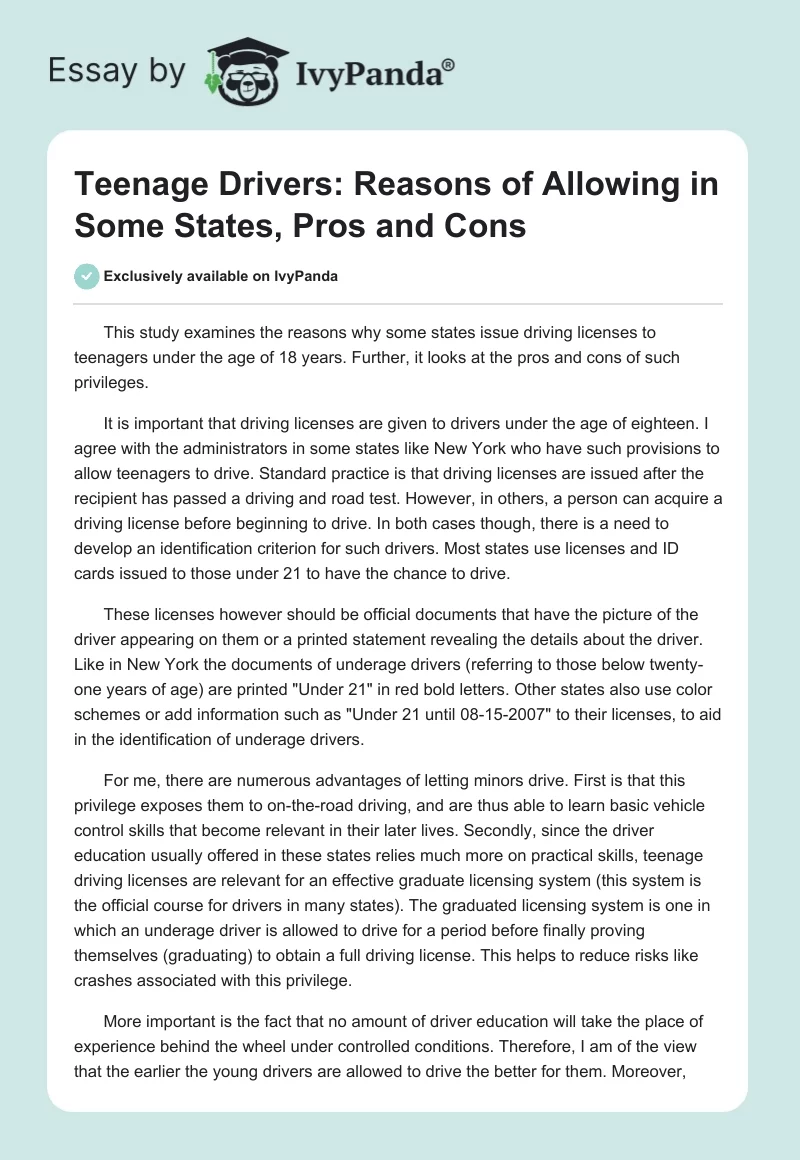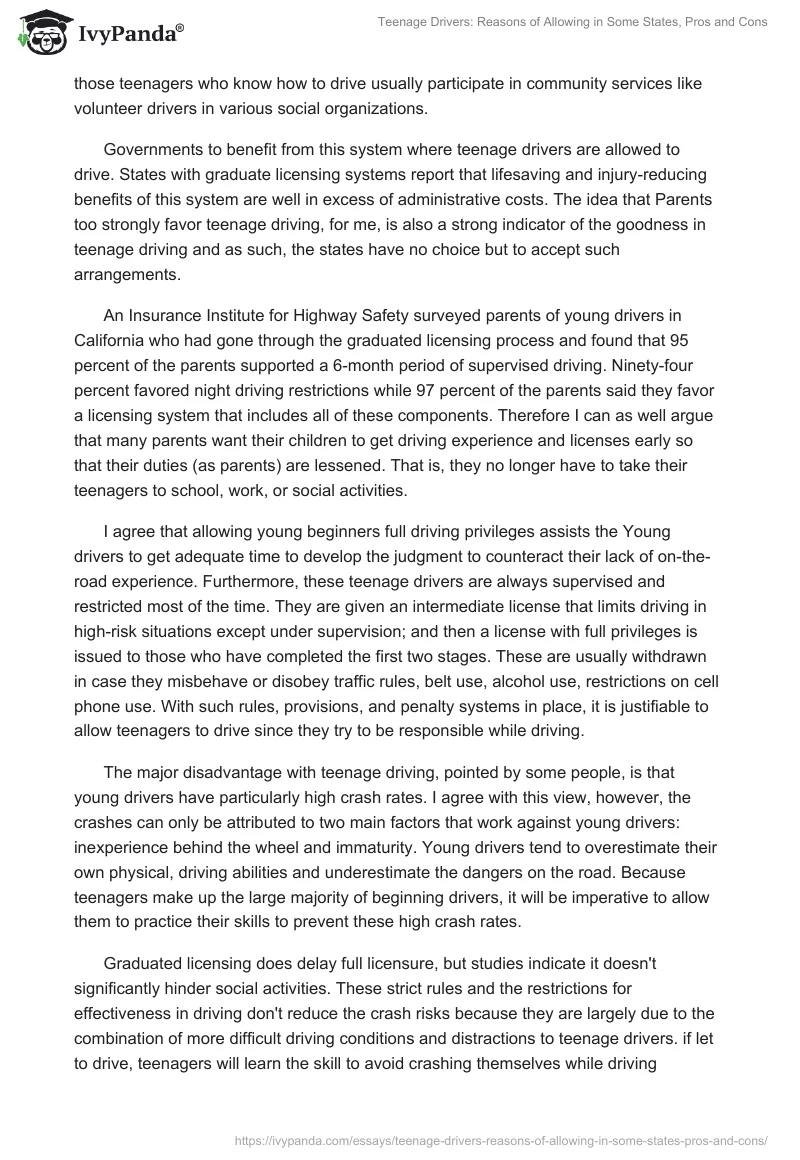This study examines the reasons why some states issue driving licenses to teenagers under the age of 18 years. Further, it looks at the pros and cons of such privileges.
It is important that driving licenses are given to drivers under the age of eighteen. I agree with the administrators in some states like New York who have such provisions to allow teenagers to drive. Standard practice is that driving licenses are issued after the recipient has passed a driving and road test. However, in others, a person can acquire a driving license before beginning to drive. In both cases though, there is a need to develop an identification criterion for such drivers. Most states use licenses and ID cards issued to those under 21 to have the chance to drive.
These licenses however should be official documents that have the picture of the driver appearing on them or a printed statement revealing the details about the driver. Like in New York the documents of underage drivers (referring to those below twenty-one years of age) are printed “Under 21” in red bold letters. Other states also use color schemes or add information such as “Under 21 until 08-15-2007” to their licenses, to aid in the identification of underage drivers.
For me, there are numerous advantages of letting minors drive. First is that this privilege exposes them to on-the-road driving, and are thus able to learn basic vehicle control skills that become relevant in their later lives. Secondly, since the driver education usually offered in these states relies much more on practical skills, teenage driving licenses are relevant for an effective graduate licensing system (this system is the official course for drivers in many states). The graduated licensing system is one in which an underage driver is allowed to drive for a period before finally proving themselves (graduating) to obtain a full driving license. This helps to reduce risks like crashes associated with this privilege.
More important is the fact that no amount of driver education will take the place of experience behind the wheel under controlled conditions. Therefore, I am of the view that the earlier the young drivers are allowed to drive the better for them. Moreover, those teenagers who know how to drive usually participate in community services like volunteer drivers in various social organizations.
Governments to benefit from this system where teenage drivers are allowed to drive. States with graduate licensing systems report that lifesaving and injury-reducing benefits of this system are well in excess of administrative costs. The idea that Parents too strongly favor teenage driving, for me, is also a strong indicator of the goodness in teenage driving and as such, the states have no choice but to accept such arrangements.
An Insurance Institute for Highway Safety surveyed parents of young drivers in California who had gone through the graduated licensing process and found that 95 percent of the parents supported a 6-month period of supervised driving. Ninety-four percent favored night driving restrictions while 97 percent of the parents said they favor a licensing system that includes all of these components. Therefore I can as well argue that many parents want their children to get driving experience and licenses early so that their duties (as parents) are lessened. That is, they no longer have to take their teenagers to school, work, or social activities.
I agree that allowing young beginners full driving privileges assists the Young drivers to get adequate time to develop the judgment to counteract their lack of on-the-road experience. Furthermore, these teenage drivers are always supervised and restricted most of the time. They are given an intermediate license that limits driving in high-risk situations except under supervision; and then a license with full privileges is issued to those who have completed the first two stages. These are usually withdrawn in case they misbehave or disobey traffic rules, belt use, alcohol use, restrictions on cell phone use. With such rules, provisions, and penalty systems in place, it is justifiable to allow teenagers to drive since they try to be responsible while driving.
The major disadvantage with teenage driving, pointed by some people, is that young drivers have particularly high crash rates. I agree with this view, however, the crashes can only be attributed to two main factors that work against young drivers: inexperience behind the wheel and immaturity. Young drivers tend to overestimate their own physical, driving abilities and underestimate the dangers on the road. Because teenagers make up the large majority of beginning drivers, it will be imperative to allow them to practice their skills to prevent these high crash rates.
Graduated licensing does delay full licensure, but studies indicate it doesn’t significantly hinder social activities. These strict rules and the restrictions for effectiveness in driving don’t reduce the crash risks because they are largely due to the combination of more difficult driving conditions and distractions to teenage drivers. if let to drive, teenagers will learn the skill to avoid crashing themselves while driving
Although prone to risks, the benefits of teenage driving far outweigh the risks. I believe that safety and competency in driving is a result of extensive practice in a wide variety of driving and traffic conditions by drivers and at least 50 hours of behind-the-wheel experience. Teenage driving offers the required period of skill-building and experience before taking to the road; this is a good rule of thumb for any new driver to follow and one of the basic reasons why, according to me, States should allow teenagers to drive.
Bibliography
Foss, R. D.; Feaganes, J R; and Rodgman, E.A. Initial effects of graduated driver licensing in Michigan: Early impact on motor vehicle crashes among 16-year old drivers. Journal of the American Association 286. 2001.
National Highway Traffic Safety Administration. Research agenda for improved novice driver education program. Washington, DC: Us Department of transportation: 1994.


